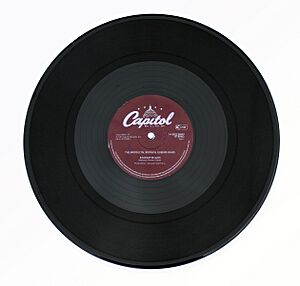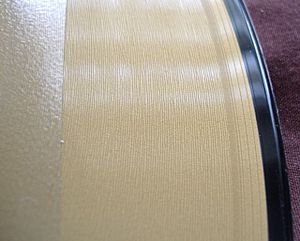Twelve-inch single facts for kids
A twelve-inch single is a special type of gramophone record. It is made of vinyl, a type of plastic. These records are 12 inches (about 30 cm) wide. They have wider grooves and usually only one or a few songs on each side. This is different from LP records, which have many songs.
The wider grooves on a 12-inch single allow for louder sound. This also means the sound quality can be better. DJs often use these records in clubs, especially for disco and dance music. They play at either 33⅓ or 45 revolutions per minute (rpm). Regular 7-inch singles usually hold only a few minutes of music.
Contents
How 12-inch Singles Work
Twelve-inch singles have less music than full-length LPs. This means they need fewer grooves per inch. This extra space lets the sound be recorded much louder. The needle on the record player can move more freely. This is especially good for bass sounds, which are important in dance music. Many record companies started making 12-inch singles in the 1970s. They often played at 33⅓ rpm, even though 45 rpm gives clearer high sounds.
History of the 12-inch Single
Early Records Before Vinyl
Gramophone records first appeared in the late 1800s. People like Thomas Edison and Emile Berliner helped create them. In 1903, 12-inch records were introduced. These could play for up to four minutes. This was a big improvement for longer songs or speeches. By the 1910s, records became the main way to play sound. Most records played at 78 rpm by 1925. These early records were made of a brittle material called shellac.
Vinyl Records Arrive
In 1931, RCA Victor launched the first vinyl long-playing record. These records played at 33⅓ rpm. They were made of a strong plastic called vinyl. They could play for up to 20 minutes per side. The first 12-inch LP had just one song on each side. It was Beethoven's Symphony No. 5. However, these early vinyl records did not sell well. People did not have good record players, and it was during the Great Depression.
After World War II, vinyl records came back. In 1948 and 1949, Columbia Records and RCA Victor released new vinyl records. These included 12-inch LPs (with tiny grooves) and 7-inch singles.
Jamaican Music and DJs
Records made especially for DJs started in Jamaica in the 1950s. Sound system owners would give their DJs special records. These were called "dubs" and were exclusive. DJs could play these new songs before they were sold to everyone.
Before Disco Music
In March 1970, Cycle/Ampex Records tried selling a 12-inch single. It was by guitarist Buddy Fite. This was called 'The world's first 12-inch single!'. The idea was to make people buy singles again. It played at 33 rpm, just like the album version.
First Instrumental Side
In 1973, a record label called Scepter released a 7-inch single. On the other side (the B-side), it had just the instrumental version of the song. This was a big deal for DJs. They could use two record players to mix the vocal and instrumental parts. This made the song last longer for dancers. This helped make instrumental B-sides a common practice for dance records.
First Extended Song Edit
In early 1974, a famous disco mixer named Tom Moulton started making longer versions of songs. He wanted to make songs longer than the usual three minutes for radio. He took a song called "Dream World" by Don Downing. Moulton stretched the song to almost double its original length. This new, longer version was called a "disco break." This idea was later released on a 7-inch record in July 1974.
First Mixed Songs on an Album
Tom Moulton also created the first album with songs linked together. This was for Gloria Gaynor's Never Can Say Goodbye album in January 1975. Three songs were put together as one long, 18-minute track. It was made perfectly for dancing. This was the first "DJ mix" put on a vinyl record.
Early Special Records for DJs
The first large record made just for DJs was a 10-inch "acetate" record. This happened in 1974. A sound engineer needed a test copy of a remix by Tom Moulton. They used a 10-inch blank record because no 7-inch ones were available. Moulton realized that with wider grooves, the sound could be much louder and clearer. This "hotter" sound was perfect for discothèques.
Later, a 12-inch test record was made for the song "Free Man" by South Shore Commission. Only about 10 of these were made for local DJs. These records often had plain white labels or just handwritten notes. DJs would test these remixes in clubs to see how dancers liked them.
Promoting Records to DJs
As the disco scene grew, magazines like Billboard started writing about it. Record companies began to see how important DJs were. They realized DJs helped make songs popular. In June 1975, record pools were started in New York. These groups helped give new records to DJs before they were sold.
Record labels then started making records especially for DJs. Scepter Records announced they would send out '12-inch 45s' to DJs. These records had high volume levels and longer tracks. Atlantic Records was the first major label to send out 12-inch 33 rpm vinyl promos to DJs in July 1975.
First Widely Sent Out 12-inch Promo
According to Tom Moulton, the first widely distributed 12-inch promotional single was Frankie Valli's "Swearin' To God". It was released by Private Stock Records in June 1975. It had a long playing time of over 10 minutes.
| Artist | Title | Label | Release month | |
|---|---|---|---|---|
| Carol Douglas | The Carol Douglas Album sampler | Midland International | February | |
| Frankie Valli | "Swearin' To God" | Private Stock | April (10-inch) / June | |
| Bobby Moore | "(Call Me Your) Anything Man" | Scepter | June | |
| Banzaii | "Chinese Kung Fu" | Scepter | June | |
| Calhoon | "(Do You Wanna) Dance, Dance, Dance" | Warner-Spector | May (10-inch) / July | |
| Barrabas | "Mellow Blow" | Atlantic | July | |
| The Eleventh Hour | "Hollywood Hot" | 20th Century | July | |
| Philly Devotions | "I Just Can't Make It" | Columbia | August | |
| The Trammps | "Hooked For Life" | Atlantic | August | |
| Ace Spectrum | "Keep Holdin' On" | Atlantic | August | |
| Secrets | "(Baby) Save Me" | Scepter | August | |
| The Chequers | "Undecided Love" | Scepter | September | |
| Touch of Class | "I'm in Heaven" | Midland International | September | |
| Silver Convention | "Always Another Girl" / "Fly, Robin, Fly" | Midland International | September | |
| Ronnie Spector | "You'd Be Good For Me" | Tom Cat | September | |
| War | "Low Rider" | United Artists | September | |
| The Miracles | "Love Machine" | Tamla (Motown) | September | |
| David Ruffin | "Walk Away From Love" | Motown | September | |
| Soul Train Gang | "Soul Train '75" | Soul Train | September | |
| Natural Order | "Jealousy" | Sound of Washington D.C. | September | |
| Ernie Bush | "Breakaway" | Scepter-Contempo | October | |
| Gary Toms Empire | "Drive My Car" | PIP/Pickwick | October | |
| The Ritchie Family | "I Want To Dance" | 20th Century | October | |
| The Wiz / Hot Chocolate | "Tornado" / "Disco Queen" | Atlantic | October | |
| Vicki Sue Robinson | "Never Gonna Let You Go" | RCA | November | |
| Papa John Creach & the Midnight Sun | "Joyce" | Buddah | November | |
| Ralph Carter | "Extra Extra" | Mercury | November | |
| Jimmy James and the Vagabonds | "I Am Somebody" | Pye | November | |
| The Blackbyrds | "Happy Music" | Fantasy | November | |
| Gail | "Consideration" | SMI | December |
First 12-inch Records Sold to the Public
Record labels realized that 12-inch singles were popular. People wanted to buy the longer versions they heard in clubs. Some promotional 12-inch singles were even being sold for high prices.
The first 12-inch single sold to the public was "Ten Percent" by Double Exposure. It was released by Salsoul Records in May 1976. This record had a special long remix for dancers. It quickly became very popular.
Other early 12-inch singles sold to the public included:
- Jesse Green "Nice And Slow" / Sweet Music "I Get Lifted" (June 1976)
- Two George Benson songs "Summertime 2001" / "Theme From Good King Bad" (June 1976)
- Moment of Truth "So Much For Love" / "Helplessly" (July 1976)
12-inch Singles Around the World
The idea of 12-inch singles spread quickly.
- Jamaica: Jamaican reggae artists started making their own 12-inch singles called "discomixes" around 1977.
- United Kingdom: The UK started using 12-inch singles a bit later than the US. They were first used to promote artists. The louder sound and better quality were big benefits. By the late 1970s, longer versions of US disco songs became popular in the UK. The first 12-inch singles sold in the UK were Ernie Bush "Breakaway" and Banzaii "Chinese Kung Fu" in October 1976.
What Happened Next
Decline and Continued Use
Vinyl records faced competition from other music formats. These included cassette tapes and later, CDs. In 1988, CDs started selling more than records. Between 1988 and 1991, vinyl records became much less popular. Record companies stopped making many vinyl titles. This made it harder to find 12-inch singles. Some people think this was done to make people buy more profitable CDs.
However, 12-inch singles are still important for dance music and DJs. Many DJs still prefer the sound of vinyl. Some DJs even have "vinyl only" nights. New 12-inch singles are still being made and sold. There is also a big market for old, second-hand 12-inch singles online. Collectors often look for rare and valuable records.
See also
 In Spanish: Doce pulgadas para niños
In Spanish: Doce pulgadas para niños



